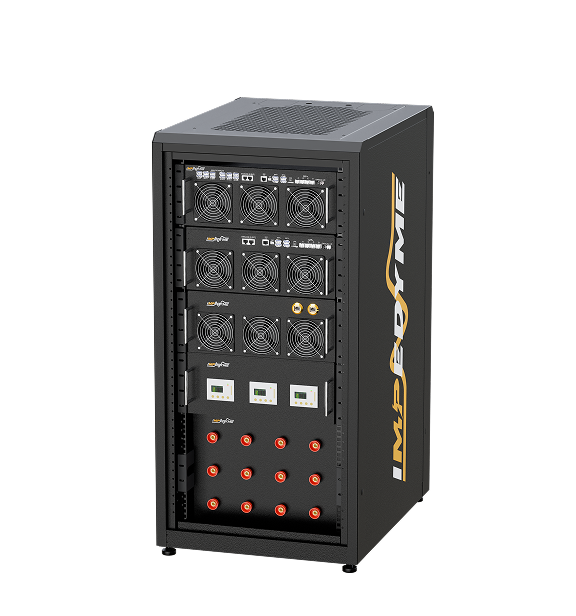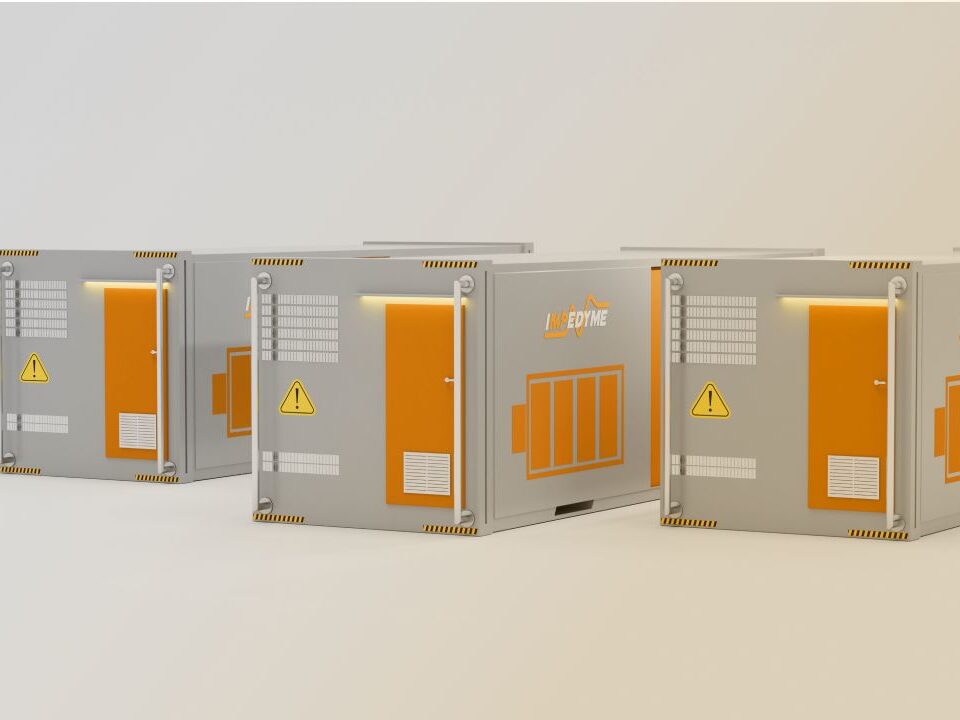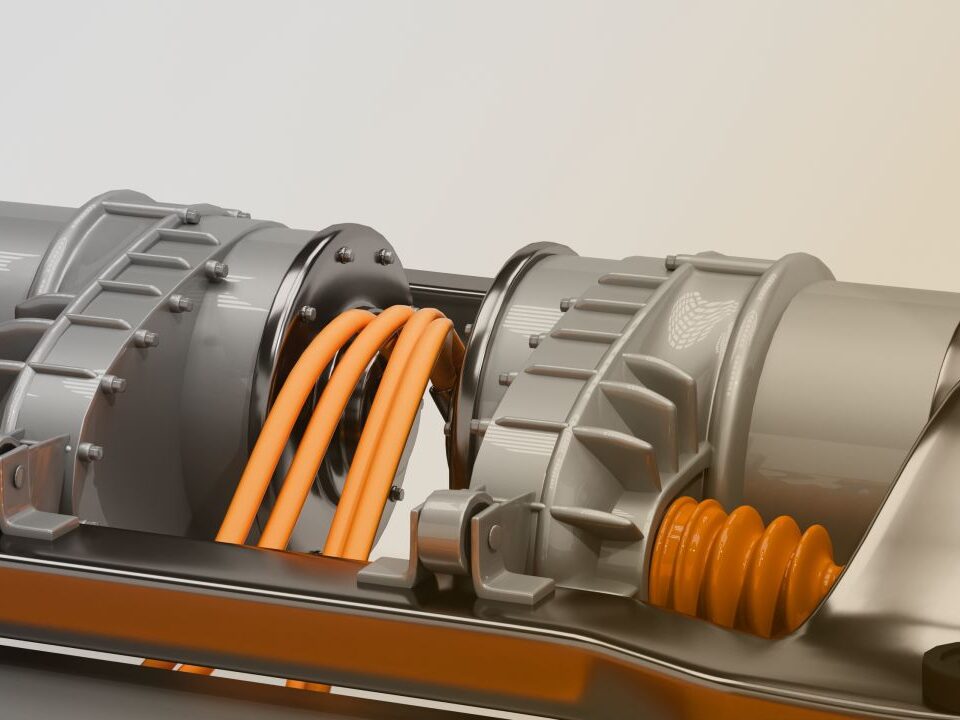
-
 Induction Motor
Induction Motor
-
 Automotive Electrical System Simulation
Automotive Electrical System Simulation
-
 DC/DC Bidirectional Converter
DC/DC Bidirectional Converter
-
 PWM Control for Brushless DC
PWM Control for Brushless DC
-
 BLDC Motor Control and Drive Simulation
BLDC Motor Control and Drive Simulation
-
 Electric Vehicle Fast Charger Simulation
Electric Vehicle Fast Charger Simulation
-
 DFIG Wind Turbine Simulation
DFIG Wind Turbine Simulation
-
 Dual Active Bridge
Dual Active Bridge
-
 EV Dynamometer Test Environment Simulation
EV Dynamometer Test Environment Simulation
-
 Electric Vehicle Simulation
Electric Vehicle Simulation
-
 Three-Phase Grid-Connected Inverter Using Direct-Q…
Three-Phase Grid-Connected Inverter Using Direct-Q…
-
 Three-Phase Grid-Connected Solar Photovoltaic
Three-Phase Grid-Connected Solar Photovoltaic
-
 Grid-Connected Rectifier
Grid-Connected Rectifier
-
 Grid-Tied Inverter System
Grid-Tied Inverter System
-
 Torque Control in a Hybrid Excitation Synchronous …
Torque Control in a Hybrid Excitation Synchronous …
-
 Wye-Delta Starting Circuit
Wye-Delta Starting Circuit
-
 IPMSM-Based Axle-Drive
IPMSM-Based Axle-Drive
-
 Simplified Parallel Hybrid Electric Vehicle
Simplified Parallel Hybrid Electric Vehicle
-
 Simplified Series Hybrid Electric Vehicle
Simplified Series Hybrid Electric Vehicle
-
 Series-Parallel Hybrid Electric Vehicle
Series-Parallel Hybrid Electric Vehicle
-
 Three-Phase Matrix Converter Simulation
Three-Phase Matrix Converter Simulation
-
 Venturini Modulation for Three-Phase Matrix Conver…
Venturini Modulation for Three-Phase Matrix Conver…
-
 Microgrid Frequency Regulation Using Vehicle-to-Gr…
Microgrid Frequency Regulation Using Vehicle-to-Gr…
-
 Three-Phase Modular Multilevel Converter
Three-Phase Modular Multilevel Converter
-
 Field-Oriented Control
Field-Oriented Control
-
 Interior Permanent Magnet Synchronous Generator
Interior Permanent Magnet Synchronous Generator
-
 Permanent Magnet Synchronous Machine
Permanent Magnet Synchronous Machine
-
 PMSM Rotor Angular Velocity
PMSM Rotor Angular Velocity
-
 PMSM-Based Electrical Traction Drive
PMSM-Based Electrical Traction Drive
-
 Maximum Power Point Tracking
Maximum Power Point Tracking
-
 Six-Phase Permanent Magnet Synchronous Machine
Six-Phase Permanent Magnet Synchronous Machine
-
 Synchronous Machine-Based Electrical Drive Simulat…
Synchronous Machine-Based Electrical Drive Simulat…
-
 Single-Stage Solar Inverter
Single-Stage Solar Inverter
-
 Three-Phase Cycloconverter Simulation
Three-Phase Cycloconverter Simulation
-
 Totem-Pole PFC Simulation
Totem-Pole PFC Simulation
-
 Twelve-Pulse Thyristor Rectifier
Twelve-Pulse Thyristor Rectifier
-
 Two-Wheeler On-Board Charger
Two-Wheeler On-Board Charger
-
 Vienna Rectifier Simulation
Vienna Rectifier Simulation
-
 High-Voltage Direct Current
High-Voltage Direct Current
-
 Wireless Power Transfer
Wireless Power Transfer
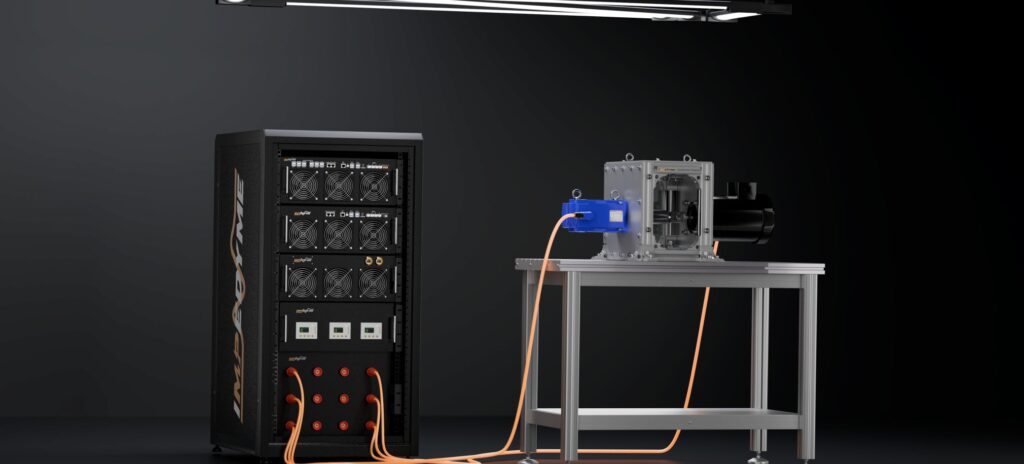
Comprehensive Documentation for Automotive Electrical System Simulation
Table of Contents
- 1 Comprehensive Documentation for Automotive Electrical System Simulation
- 1.1 Introduction
- 1.2 System Overview
- 1.2.1 What is an Automotive Electrical System?
- 1.2.2 Purpose of the Simulation
- 1.3 Key Features
- 1.3.1 Dynamic Load Management
- 1.3.2 Alternator and Battery Interaction
- 1.3.3 Fault Detection and Diagnosis
- 1.3.4 Cost Savings
- 1.3.5 Faster Time-to-Market
- 1.3.6 Improved Reliability
- 1.3.7 Enhanced Safety
- 1.4 Simulation Objectives
- 1.5 Technical Description
- 1.5.1 System Configuration
- 1.5.2 Control Methodology
- 1.6 Advantages of Automotive Electrical System Simulation
- 1.7 Applications
- 1.7.1 Electric and Hybrid Vehicle Development
- 1.7.2 Advanced Driver-Assistance Systems (ADAS)
- 1.7.3 Power Distribution and Wiring Harness Design
- 1.7.4 Thermal Management
- 1.7.5 Conventional Vehicles:
- 1.7.6 Prototyping and Validation
- 1.8 Simulation Benefits
- 1.9 Summary
- 1.10 Future Enhancements
- 1.10.1 Induction Motor
- 1.10.2 DC/DC Bidirectional Converter
- 1.10.3 PWM Control for Brushless DC
- 1.10.4 BLDC Motor Control and Drive Simulation
Introduction
Modern vehicles rely on complex electrical systems that integrate various subsystems to ensure efficient power distribution and reliable operation. This project focuses on developing a simplified dynamic model of an automotive electrical system, incorporating electrical, mechanical, and thermal interactions. The simulation provides insights into power distribution, system fluctuations, and the effects of different electrical loads, aiding in the analysis and optimization of vehicle electrical networks.
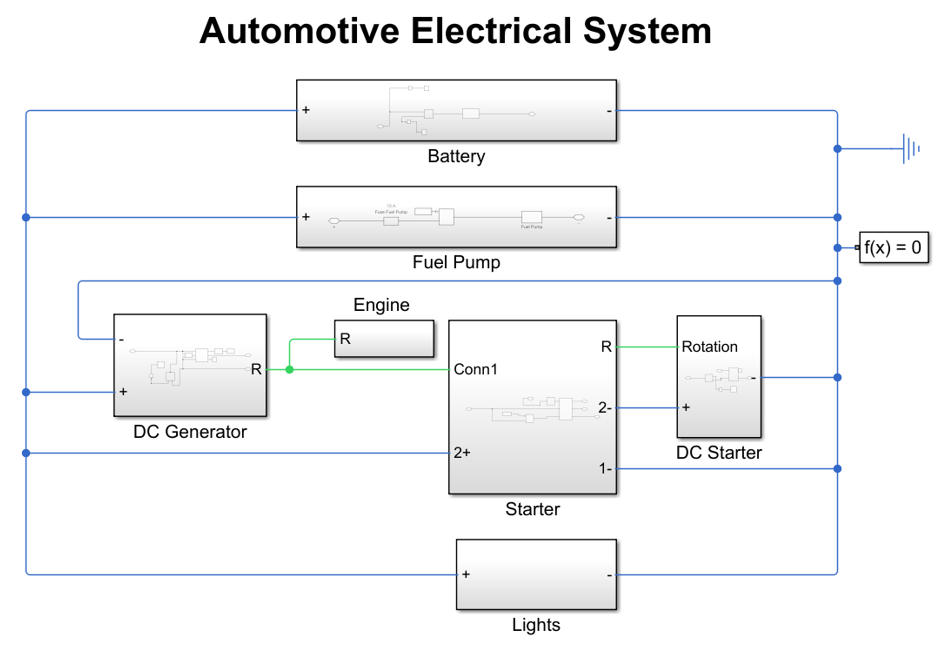
System Overview
What is an Automotive Electrical System?
An automotive electrical system consists of a battery, alternator, loads (such as lighting, HVAC, infotainment, and engine control units), and a network of power distribution and control circuits. Efficient management of power within the vehicle is crucial for performance, reliability, and safety.
Purpose of the Simulation
The simulation aims to:
- Model power generation, storage, and distribution in a vehicle.
- Analyze load fluctuations and power stability during driving conditions.
- Optimize energy management strategies for improved efficiency and reduced power losses.
Key Features
Dynamic Load Management
The simulation models different electrical loads in real time to analyze their impact on system stability and battery performance. ➡️ HIL/PHIL Benefit: Real-time load emulation allows testing how vehicle electrical systems respond to sudden load changes.
Alternator and Battery Interaction
Simulates how the alternator charges the battery under various operating conditions, including idling, acceleration, and regenerative braking. ➡️ HIL/PHIL Benefit: Enables precise validation of charging strategies and alternator efficiency.
Fault Detection and Diagnosis
The model can simulate electrical faults such as overvoltage, undervoltage, and short circuits to study system resilience. ➡️ HIL/PHIL Benefit: Helps in validating fault detection algorithms and safety mechanisms.
Cost Savings
Reduces the need for physical prototypes and testing, lowering development costs.
Faster Time-to-Market
Accelerates the design and validation process, enabling faster product launches.
Improved Reliability
Identifies and resolves potential issues early in the design phase, improving system reliability.
Enhanced Safety
Ensures compliance with safety standards, reducing the risk of failures and accidents.
Simulation Objectives
This simulation helps evaluate:
- Power distribution efficiency across vehicle subsystems.
- Impact of electrical loads on battery life and alternator performance.
- Effectiveness of energy management strategies in reducing fuel consumption. ➡️ HIL/PHIL Benefit: Provides a testing ground for optimizing power control algorithms before real-world deployment.
Technical Description
System Configuration
- Power Source: 12V or 48V automotive battery and alternator.
- Loads: Headlights, HVAC, infotainment, electric power steering, auxiliary units.
- Control System: Power management unit optimizing power flow based on driving conditions.
Control Methodology
- Load Shedding and Prioritization: Ensures critical systems receive power during high-demand conditions.
- Voltage Regulation: Maintains stable voltage levels across the vehicle.
- Energy Recovery Mechanisms: Implements regenerative braking for enhanced energy efficiency. ➡️ HIL/PHIL Benefit: Control logic can be tested in simulated environments before vehicle integration.
Advantages of Automotive Electrical System Simulation
- Predictive Maintenance: Identifies potential failures before they impact vehicle performance.
- Optimized Energy Efficiency: Reduces unnecessary power consumption, extending battery life.
- Enhanced Safety and Reliability: Simulates fault conditions to improve protective mechanisms. ➡️ HIL/PHIL Benefit: Enables real-time validation of vehicle electrical system performance under varying scenarios.
Applications
Electric and Hybrid Vehicle Development
Battery Management Systems (BMS): Simulation is used to design and optimize BMS for monitoring and controlling battery performance, ensuring safety, longevity, and efficiency.
Power Electronics: Simulations help design and test inverters, converters, and motor controllers for electric drivetrains, ensuring optimal performance and thermal management.
Energy Efficiency Optimization: Simulations are used to analyze and optimize the energy consumption of EVs and hybrid vehicles, improving range and reducing costs.
Advanced Driver-Assistance Systems (ADAS)
Sensor Integration: Simulations help integrate and test sensors (e.g., radar, LiDAR, cameras) used in ADAS, ensuring accurate and reliable operation.
Control Algorithms: Simulations are used to develop and test control algorithms for features like adaptive cruise control, lane-keeping assist, and automatic emergency braking.
Functional Safety: Simulations ensure that ADAS systems comply with safety standards like ISO 26262, reducing the risk of failures.
Power Distribution and Wiring Harness Design
Wiring Harness Optimization: Simulations are used to optimize the design of wiring harnesses, reducing weight, cost, and complexity while ensuring reliability.
Load Analysis: Simulations help analyze electrical loads in the vehicle, ensuring that the power distribution system can handle all components without overloading.
Fault Detection: Simulations are used to test the electrical system’s response to faults, such as short circuits or open circuits, improving safety and reliability.
Thermal Management
Component Cooling: Simulations help design cooling systems for electrical components like batteries, motors, and power electronics, ensuring optimal operating temperatures.
Heat Dissipation Analysis: Simulations analyze heat dissipation in the electrical system, preventing overheating and improving component lifespan.
Conventional Vehicles:
Improves fuel economy through better alternator control. ➡️ HIL/PHIL Benefit: Accelerates development and validation of vehicle electrical architectures.
Prototyping and Validation
Virtual Prototyping: Simulations reduce the need for physical prototypes, saving time and cost during the development process.
System Integration Testing: Simulations are used to test the integration of electrical systems with mechanical and software components, ensuring seamless operation.
Simulation Benefits
With this simulation, users can:
- Analyze electrical load interactions in real time.
- Optimize power management strategies for reduced energy consumption.
- Validate fault protection mechanisms for improved system reliability. ➡️ HIL/PHIL Benefit: Translates simulation results into real-world testing for refined vehicle design.
Summary
The Automotive Electrical System Simulation provides a detailed framework for analyzing vehicle power distribution, load variations, and energy efficiency. By leveraging Impedyme’s HIL and PHIL solutions, the development process is enhanced:
| Development Stage | Impedyme’s Contribution |
|---|---|
| Control Design | RCP using HIL for rapid algorithm validation |
| Control Hardware Testing | CIL with real-time automotive models |
| Power Stage Verification | PHIL with real voltage and power interaction |
| Final Validation | Full-system PHIL under realistic driving conditions |
Future Enhancements
- AI-Based Predictive Energy Management for Smart Vehicles.
- Integration of Wireless Charging and Advanced Power Distribution Networks.
- Development of Next-Generation 800V Automotive Electrical Architectures.
The Automotive Electrical System Simulation serves as a powerful tool for developing next-generation vehicle power networks. With Impedyme’s HIL/PHIL platforms, engineers can refine electrical architectures, optimize power efficiency, and ensure reliable system operation before deployment in real-world vehicles.
